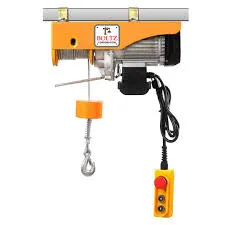


The Importance of Electric Winches and Wireless Remote Controls
Electric winches have revolutionized the way we lift, pull, and handle heavy loads in various industries, including construction, shipping, and recreational activities. One of the most significant advancements in the functionality of electric winches is the integration of wireless remote controls. This technological enhancement offers a myriad of benefits that make operations safer, more efficient, and user-friendly.
What is an Electric Winch?
An electric winch is a device that utilizes a motor to wind a rope or cable around a drum. It is primarily used to lift or pull heavy objects with minimal effort. The application of electric winches extends beyond just heavy machinery in industrial settings; they are also a common sight in recreational activities such as off-roading and boating. Electric winches are favored for their ability to exert a substantial amount of pulling power, allowing users to perform tasks that would otherwise require multiple workers or heavy equipment.
The Role of Wireless Remote Controls
The introduction of wireless remote controls in electric winch operations has been a game-changer. These remote systems eliminate the need for operators to be physically near the winch, thereby facilitating greater flexibility and safety. With a wireless remote, operators can control the winch from a distance, ensuring they are at a safe location while performing potentially hazardous lifting tasks.
Enhanced Safety
One of the most critical advantages of using a wireless remote control with an electric winch is the enhancement of safety measures. Situations involving heavy lifting can be unpredictable, and being situated close to the load can pose risks. By utilizing a remote control, operators can oversee the operation from a safe distance, reducing the likelihood of injury from accidents or equipment failures.

Improved Efficiency
Efficiency in lifting and pulling operations is critical for productivity. Wireless remote controls allow for seamless communication with the winch, which means operators can make immediate adjustments without having to run back and forth. This capability allows for more precise control over the winching process. As a result, jobs can be completed faster, leading to increased productivity and reduced labor costs.
Versatility and Convenience
Wireless remote controls add versatility to the operation of electric winches. Operators can easily switch between different functions, such as lifting and lowering loads, all from the convenience of a handheld device. Additionally, remote controls can often be used with various winch models and types, which means that a single remote can serve multiple machines. This consolidation is not only convenient but also helps to reduce the clutter associated with multiple controls.
Applications in Various Industries
The combination of electric winches with wireless remote controls can be seen across several industries. In construction, workers often use winches to lift heavy materials to elevated areas, and the wireless feature allows for greater on-site mobility. In marine applications, boaters utilize electric winches with remote controls to anchor or pull their vessels without needing to be aboard. Similarly, in the towing and recovery sector, professionals benefit from the wireless feature to manage the vehicle recovery process more effectively.
Conclusion
The adaptation of wireless remote controls for electric winches marks a significant advancement in machinery operation. The combination of enhanced safety, improved efficiency, and versatility makes electric winches equipped with wireless remotes a preferred choice across various industries. As technology continues to evolve, it is likely that we will see further innovations in winching systems, providing even more benefits to operators and safety professionals alike. Whether for recreational or industrial purposes, the integration of these technologies in electric winches is undoubtedly shaping the future of material handling.



